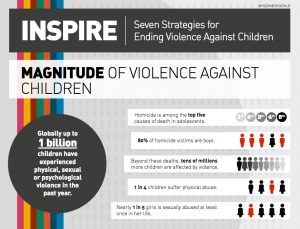Th e 2006 UN Secretary General’s Study on Violence against Children revealed that globally children experienced a staggering level of violence, despite extensive international human rights obligations accepted by states.
e 2006 UN Secretary General’s Study on Violence against Children revealed that globally children experienced a staggering level of violence, despite extensive international human rights obligations accepted by states.
The study called for urgent action and presented clear recommendations as to how states and other actors ought respond.
Despite some progress, approximately 1 billion children worldwide have experienced physical, sexual or psychological violence in the past year. The violence can take many forms and includes sexual violence and abuse, physical violence, including corporal punishment, all forms of emotional violence (ridicule, verbal abuse, bullying, etc) and negligence.
A recent side-event at the UN Human Rights Council sought to review progress in the 10 years since the report, and to suggest ways forward, particularly in the light of the world leader’s commitment to ‘end abuse, exploitation, trafficking and all forms of violence and torture against children’ as part of the Sustainable Development Goals.
INSPIRE is a collection of strategies for ending violence against children initiated by the World Health Organisation in partnership with a range of NGos and agencies
These strategies are outlined below:-
Implementation and enforcement of laws. The Firearms Control Act in South Africa saved a number of lives after being introduced. The largest demographic of people killed due to gun violence in South Africa are adolescents.
Norms and values. We see violence at home as a private matter. Many countries have banned corporal punishment at school but not at home for example. These restrictive and harmful gender and social norms must change through education, bystander interventions, community programs etc.
Safe Environments. Where children spend their time must be safe. This includes addressing “hotspots” of violence, interrupting the spread of violence and improving the built environment. A focus on modifying communities’ environment, rather than the individuals within it, will foster positive and deter harmful behaviours.
Parent and caregiver support. A reduction in harsh parenting practices and creation of positive parent-child relationships will lead to a reduction in child maltreatment. It is important to have comprehensive training programs which focus on non-violent discipline alternatives and effective communication.
Income and economic strengthening will reduce physical child maltreatment, exposure to domestic violence, early child marriages etc. Approaches such as cash transfers to families on the condition that their children attend school is one such example.
Response and support services. Access to quality health, social welfare, reporting and criminal justice systems breaks children out of the cycle of violence. It reduces trauma and negative health outcomes
Education and life skills. Effective education for children protects against both victimisation and perpetration of violence. It also reduces drug use and excessive alcohol use in children.
Adolescents and Youth are invited to join the 19 days of Activism for the Prevention of Violence Against Children and Youth